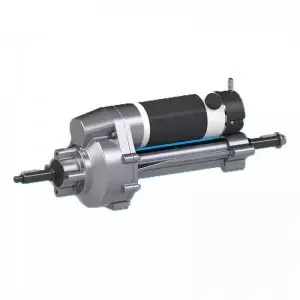Introduction
The design of electric transaxles plays a crucial role in the overall performance and efficiency of electric vehicles (EVs). One of the key factors that significantly impact the vehicle’s performance is its weight. The weight of an electric vehicle affects not only its energy consumption and range but also its handling, acceleration, and braking performance. Therefore, understanding how the design of electric transaxles influences the overall vehicle weight is essential for optimizing EV performance and meeting the growing demand for sustainable and efficient transportation solutions.
The Role of Electric Transaxles in Vehicle Weight
1. Integration of Components
Electric transaxles are designed to integrate multiple components, including the electric motor, gearbox, and differential, into a single compact unit. This integration can lead to weight savings compared to traditional multi-component systems. By combining these elements, manufacturers can reduce the overall volume and weight of the powertrain, contributing to a lighter vehicle. For example, some advanced electric transaxle designs can achieve weight reductions of up to 15% compared to conventional setups.
2. Material Selection
The choice of materials used in the construction of electric transaxles also has a significant impact on vehicle weight. High-strength, lightweight materials such as aluminum alloys and advanced composites are often used to reduce the weight of the transaxle housing and other components. These materials not only contribute to weight savings but also maintain the structural integrity and durability required for reliable performance.
3. Gearbox Design
The design of the gearbox within the electric transaxle is another critical factor affecting vehicle weight. Multi-speed gearboxes can optimize the motor’s operating efficiency across a wider range of driving conditions, allowing for the use of smaller, lighter motors without compromising performance. This can lead to further weight reductions while maintaining or even improving the vehicle’s acceleration and top speed capabilities.
4. Motor Efficiency
The efficiency of the electric motor directly influences the overall weight of the vehicle. High-efficiency motors can deliver the same power output with less mass, contributing to a lighter powertrain. Additionally, efficient motors generate less heat, reducing the need for heavy cooling systems and further minimizing weight.
Impact on Vehicle Performance
1. Energy Consumption and Range
Reducing the overall weight of an electric vehicle through optimized transaxle design can lead to significant improvements in energy consumption and range. Lighter vehicles require less energy to accelerate and maintain speed, resulting in lower electricity consumption and longer driving ranges. For example, a 10% reduction in vehicle weight can lead to a corresponding increase in range of up to 10%.
2. Handling and Dynamics
A lighter vehicle generally exhibits better handling characteristics, including improved responsiveness, stability, and braking performance. Optimizing the weight distribution through the design of the electric transaxle can enhance the vehicle’s dynamic behavior, providing a more enjoyable and safer driving experience.
3. Acceleration and Top Speed
Efficient and lightweight electric transaxles can contribute to better acceleration and higher top speeds. By optimizing the motor’s operating efficiency and reducing the weight of the powertrain, vehicles can achieve faster acceleration times and higher maximum speeds without compromising energy efficiency.
Design Considerations for Weight Optimization
1. Compact Design
Adopting a compact design philosophy for electric transaxles can help minimize weight while maintaining performance. This involves optimizing the layout of components to reduce the overall size and mass of the transaxle. For example, some manufacturers use innovative packaging solutions to integrate the motor, gearbox, and differential in a way that reduces the overall footprint and weight of the system.
2. Advanced Manufacturing Techniques
Utilizing advanced manufacturing techniques such as 3D printing and precision casting can enable the production of lighter and more complex components. These techniques allow for the creation of intricate geometries that can reduce material usage while maintaining structural strength, contributing to weight savings.
3. Multi-Speed Gearboxes
Incorporating multi-speed gearboxes into electric transaxle designs can optimize the motor’s operating efficiency across different driving conditions. This allows for the use of smaller, lighter motors that can still deliver high performance, resulting in weight reductions and improved energy efficiency.
4. Lightweight Materials
Selecting high-strength, lightweight materials for the construction of electric transaxles is crucial for weight optimization. Materials such as aluminum alloys and advanced composites can significantly reduce the weight of the transaxle housing and other components without compromising durability and reliability.
Case Studies and Examples
1. Tesla Model 3
The Tesla Model 3 is an excellent example of how optimized electric transaxle design can contribute to a lighter and more efficient vehicle. Tesla’s engineers have focused on integrating components, using lightweight materials, and optimizing the motor’s efficiency to achieve a compact and high-performance powertrain. As a result, the Model 3 offers impressive acceleration, a long driving range, and excellent handling characteristics, all while maintaining a relatively low overall weight.
2. Volkswagen ID.3
The Volkswagen ID.3 is another notable example of weight optimization through electric transaxle design. Volkswagen has employed advanced manufacturing techniques and lightweight materials to reduce the weight of the powertrain, contributing to the vehicle’s energy efficiency and range. The ID.3 features a multi-speed gearbox that optimizes the motor’s operating efficiency, allowing for a smaller and lighter motor without sacrificing performance.
Conclusion
The design of electric transaxles has a significant impact on the overall weight of electric vehicles. By integrating components, selecting lightweight materials, optimizing gearbox design, and improving motor efficiency, manufacturers can achieve weight reductions that lead to better energy consumption, range, handling, and performance. As the demand for sustainable and efficient transportation solutions continues to grow, optimizing the design of electric transaxles will play a crucial role in meeting these challenges and ensuring the success of electric vehicles in the global market.
Post time: Jul-25-2025


